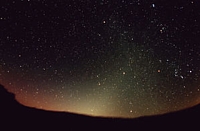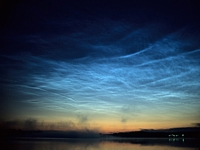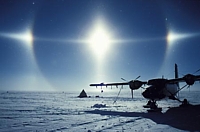zodiac light
 They are faint but significant areas of light, although not as bright as the Milky Way, extended over the horizon in a triangular shape and long after sunset. Since the glow is weak, stars can be seen through it. Zodiac light corresponds to dust particles that are spread in the shape of a disk around the Sun. Although these particles actually cover the entire sky, their presence is only evident in the plane of the horizon. Because it is seen in the ecliptic, the band where the zodiacal constellations pass, the glow receives its name.
They are faint but significant areas of light, although not as bright as the Milky Way, extended over the horizon in a triangular shape and long after sunset. Since the glow is weak, stars can be seen through it. Zodiac light corresponds to dust particles that are spread in the shape of a disk around the Sun. Although these particles actually cover the entire sky, their presence is only evident in the plane of the horizon. Because it is seen in the ecliptic, the band where the zodiacal constellations pass, the glow receives its name.
noctilucent cloud
 This phenomenon is characterized by appearing about 1 hour after sunset. They are silver-blue clouds with a noticeable spike or grid shape, which form at about 80 km altitude, where temperatures are below -100 ºC. The explanation for the formation of this strange type of "clouds that glow" in the dark is that the low amounts of water vapor at that altitude condense into meteoric dust. They are usually seen at high latitudes (between 45º and 60º) and the significant increase in their sightings is possibly due to the associated influence of environmental pollution.
This phenomenon is characterized by appearing about 1 hour after sunset. They are silver-blue clouds with a noticeable spike or grid shape, which form at about 80 km altitude, where temperatures are below -100 ºC. The explanation for the formation of this strange type of "clouds that glow" in the dark is that the low amounts of water vapor at that altitude condense into meteoric dust. They are usually seen at high latitudes (between 45º and 60º) and the significant increase in their sightings is possibly due to the associated influence of environmental pollution.
Parhelion
 It is a phenomenon of reflection and refraction of sunlight, which occurs when it is low in the sky and there are high cirrus clouds. When light is refracted in hexagonal ice crystals, two bright spots or glows are formed on both sides of the Sun, at about 22º (this is due to the angle of refraction of the light rays); refraction is divided into the colors of the rainbow, which is why it is sometimes possible to see them in the bright spots, just as it should be noted that the parhelion only constitutes the brightest points of a halo that surrounds the Sun, but which rarely achieves look complete. Halos are formed under the same meteorological principle as parhelions.
It is a phenomenon of reflection and refraction of sunlight, which occurs when it is low in the sky and there are high cirrus clouds. When light is refracted in hexagonal ice crystals, two bright spots or glows are formed on both sides of the Sun, at about 22º (this is due to the angle of refraction of the light rays); refraction is divided into the colors of the rainbow, which is why it is sometimes possible to see them in the bright spots, just as it should be noted that the parhelion only constitutes the brightest points of a halo that surrounds the Sun, but which rarely achieves look complete. Halos are formed under the same meteorological principle as parhelions.

